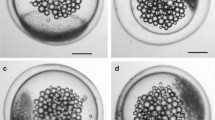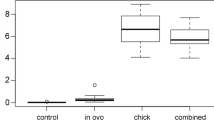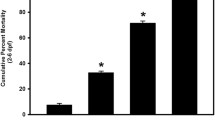Abstract
Methylmercury chloride and seleno-l-methionine were injected separately or in combinations into the fertile eggs of mallards (Anas platyrhynchos), chickens (Gallus gallus), and double-crested cormorants (Phalacrocorax auritus), and the incidence and types of teratogenic effects were recorded. For all three species, selenomethionine alone caused more deformities than did methylmercury alone. When mallard eggs were injected with the lowest dose of selenium (Se) alone (0.1 μg/g), 28 of 44 embryos and hatchlings were deformed, whereas when eggs were injected with the lowest dose of mercury (Hg) alone (0.2 μg/g), only 1 of 56 embryos or hatchlings was deformed. Mallard embryos seemed to be more sensitive to the teratogenic effects of Se than chicken embryos: 0 of 15 chicken embryos or hatchlings from eggs injected with 0.1 μg/g Se exhibited deformities. Sample sizes were small with double-crested cormorant eggs, but they also seemed to be less sensitive to the teratogenic effects of Se than mallard eggs. There were no obvious differences among species regarding Hg-induced deformities. Overall, few interactions were apparent between methylmercury and selenomethionine with respect to the types of deformities observed. However, the deformities spina bifida and craniorachischisis were observed only when Hg and Se were injected in combination. One paradoxical finding was that some doses of methylmercury seemed to counteract the negative effect selenomethionine had on hatching of eggs while at the same time enhancing the negative effect selenomethionine had on creating deformities. When either methylmercury or selenomethionine is injected into avian eggs, deformities start to occur at much lower concentrations than when the Hg or Se is deposited naturally in the egg by the mother.
Similar content being viewed by others
References
Albers PH, Koterba MT, Rossmann R, Link WA, French JB, Bennett RS et al (2007) Effects of methylmercury on reproduction in American kestrels. Environ Toxicol Chem 26:1856–1866
Conaway CH, Black FJ, Grieb TM, Roy S, Flegal AR (2008) Mercury in the San Francisco Estuary. Rev Environ Contam Toxicol 194:29–54
Cuvin-Aralar MLA, Furness RW (1991) Mercury and selenium interaction: a review. Ecotoxicol Environ Saf 21:348–364
Eagles-Smith CA, Ackerman JT, Yee J, Adelsbach TL (2009) Mercury demethylation in livers of four waterbird species: evidence for dose-response thresholds with liver total mercury. Environ Toxicol Chem 28:568–577
Evers DC, Savoy LJ, DeSorbo CR, Yates DE, Hanson W, Taylor KM et al (2008) Adverse effects from environmental mercury loads on common loons. Ecotoxicology 17:69–81
Fimreite N (1971) Effects of dietary methylmercury on ring-necked pheasants. Canadian Wildlife Service Occasional Paper 9, Ottawa
Fimreite N (1974) Mercury contamination of aquatic birds in Northwestern Ontario. J Wildl Manage 38:120–131
Finley MT, Stendell RC (1978) Survival and reproductive success of black ducks fed methyl mercury. Environ Pollut 16:51–64
Heinz GH (1979) Methylmercury: reproductive and behavioral effects on three generations of mallard ducks. J Wildl Manage 43:394–401
Heinz GH, Hoffman DJ (1998) Methylmercury chloride and selenomethionine interactions on health and reproduction in mallards. Environ Toxicol Chem 17:139–145
Heinz GH, Hoffman DJ (2003) Embryotoxic thresholds of mercury: estimates from individual mallard eggs. Arch Environ Contam Toxicol 44:257–264
Heinz GH, Hoffman DJ, Gold LG (1989) Impaired reproduction of mallards fed an organic form of selenium. J Wildl Manage 53:418–428
Heinz GH, Hoffman DJ, Kondrad SK, Erwin CA (2006) Factors affecting the toxicity of methylmercury injected into eggs. Arch Environ Contam Toxicol 50:264–279
Heinz GH, Hoffman DJ, Klimstra JD, Stebbins KR, Kondrad SL, Erwin CA (2009) Species differences in sensitivity of avian embryos to methylmercury. Arch Environ Contam Toxicol 56:129–138
Heinz GH, Hoffman DJ, Klimstra JD, Stebbins KR, Kondrad SL (2011) Toxicity of methylmercury injected into eggs when dissolved in water versus corn oil. Environ Toxicol Chem 30:2103–2106
Hill EF, Henny CJ, Grove RA (2008) Mercury and drought along the lower Carson River, Nevada: II. Snowy egret and black-crowned night-heron reproduction on Lahontan Reservoir, 1997–2006. Ecotoxicology 17:117–131
Hoffman DJ, Heinz GH (1988) Embryotoxic and teratogenic effects of selenium in the diet of mallards. J Toxicol Environ Health 24:477–490
Hoffman DJ, Moore JM (1979) Teratogenic effects of external egg applications of methyl mercury in the mallard, Anas platyrhynchos. Teratology 20:453–462
Hoffman DJ, Ohlendorf HM, Aldrich TW (1988) Selenium teratogenesis in natural populations of aquatic birds in central California. Arch Environ Contam Toxicol 17:519–525
Klimstra JD, Yee JL, Heinz GH, Hoffman DJ, Stebbins KR (in press) Interactions between methylmercury and selenomethionine injected into mallard eggs. Environ Toxicol Chem
Nishimura M, Urakawa N (1976) A transport mechanism of methyl mercury to egg albumen in laying Japanese quail. Jpn J Vet Sci 38:433–444
Norheim G (1987) Levels and interactions of heavy metals in sea birds from Svalbard and the Antarctic. Environ Pollut 47:83–94
Ochoa-Solano A, Gitler C (1968) Incorporation of 75Se-selenomethionine and 35S-methionine into chicken egg white proteins. J Nutr 94:243–248
Ohlendorf HM (1989) Bioaccumulation and effects of selenium in wildlife. In: Jacobs LW (ed) Selenium in agriculture and the environment. Special Publication No. 23. American Society of Agronomy and Soil Science Society of America, Madison, pp 133–177
Ohlendorf HM (2002) The birds of Kesterson reservoir: a historical perspective. Aquatic Toxicol 57:1–10
Ohlendorf HM, Fleming WJ (1988) Birds and environmental contaminants in San Francisco and Chesapeake Bay. Mar Pollut Bull 19:487–495
Ohlendorf HM, Hothem RL (1995) Agricultural drainwater effects on wildlife in central California. In: Hoffman DJ, Rattner BA, Burton GA Jr, Cairns J Jr (eds) Handbook of ecotoxicology. Lewis, Boca Raton, pp 577–595
Ohlendorf HM, Hoffman DJ, Saiki MK, Aldrich TW (1986a) Embryonic mortality and abnormalities of aquatic birds: apparent impacts of selenium from irrigation drainwater. Sci Total Environ 52:49–63
Ohlendorf HM, Lowe RW, Kelly PR, Harvey TE (1986b) Selenium and heavy metals in San Francisco Bay diving ducks. J Wildl Manage 50:64–71
Santolo GM, Yamamoto JT, Pisenti JM, Wilson BW (1999) Selenium accumulation and effects on reproduction in captive American kestrels fed selenomethionine. J Wildl Manage 63:502–511
Schwarzbach SE, Albertson JD, Thomas CM (2006) Effects of predation, flooding, and contamination on reproductive success of California Clapper rails (Rallus longirostris obsoletus) in San Francisco Bay. Auk 123:45–60
Skorupa JP (1998) Selenium poisoning in fish and wildlife in nature: lessons from twelve real-world examples. In: Frankenberger WT Jr, Engberg RA (eds) Environmental Chemistry of Selenium. Marcel Dekker, New York, pp 315–354
Skorupa JP, Ohlendorf HM (1991) Contaminants in drainage water and avian risk thresholds. In: Dinar A, Zilberman D (eds) The economics and management of water and drainage in agriculture. Kluwer Academic, Norwell, pp 345–368
Smith GJ, Heinz GH, Hoffman DJ, Spann JW, Krynitsky AJ (1988) Reproduction in black-crowned night-herons fed selenium. Lake Reservoir Manage 4:175–180
Stewart AR, Luoma SN, Schlekat CE, Doblin MA, Hieb KA (2004) Food web pathway determines how selenium affects aquatic ecosystems: San Francisco Bay case study. Environ Sci Technol 38:4519–4526
Tejning S (1967) Biological effects of methyl mercury dicyandiamide-treated grain in the domestic fowl Gallus gallus L. Oikos (Suppl 8), 116 pp
Wiemeyer SJ, Hoffman DJ (1996) Reproduction in eastern screech-owls fed selenium. J Wildl Manage 60:332–341
Acknowledgments
This research was funded by the CALFED Bay-Delta Program’s Ecosystem Restoration Program (Grant No. ERP-02D-C12) with additional support from the USGS Patuxent Wildlife Research Center. We thank Kevin Kenow and Collin Eagles-Smith for earlier reviews of the manuscript. Use of trade, product, or firm names does not imply endorsement by the United States Government.
Author information
Authors and Affiliations
Corresponding author
Rights and permissions
About this article
Cite this article
Heinz, G.H., Hoffman, D.J., Klimstra, J.D. et al. A Comparison of the Teratogenicity of Methylmercury and Selenomethionine Injected Into Bird Eggs. Arch Environ Contam Toxicol 62, 519–528 (2012). https://doi.org/10.1007/s00244-011-9717-4
Received:
Accepted:
Published:
Issue Date:
DOI: https://doi.org/10.1007/s00244-011-9717-4




